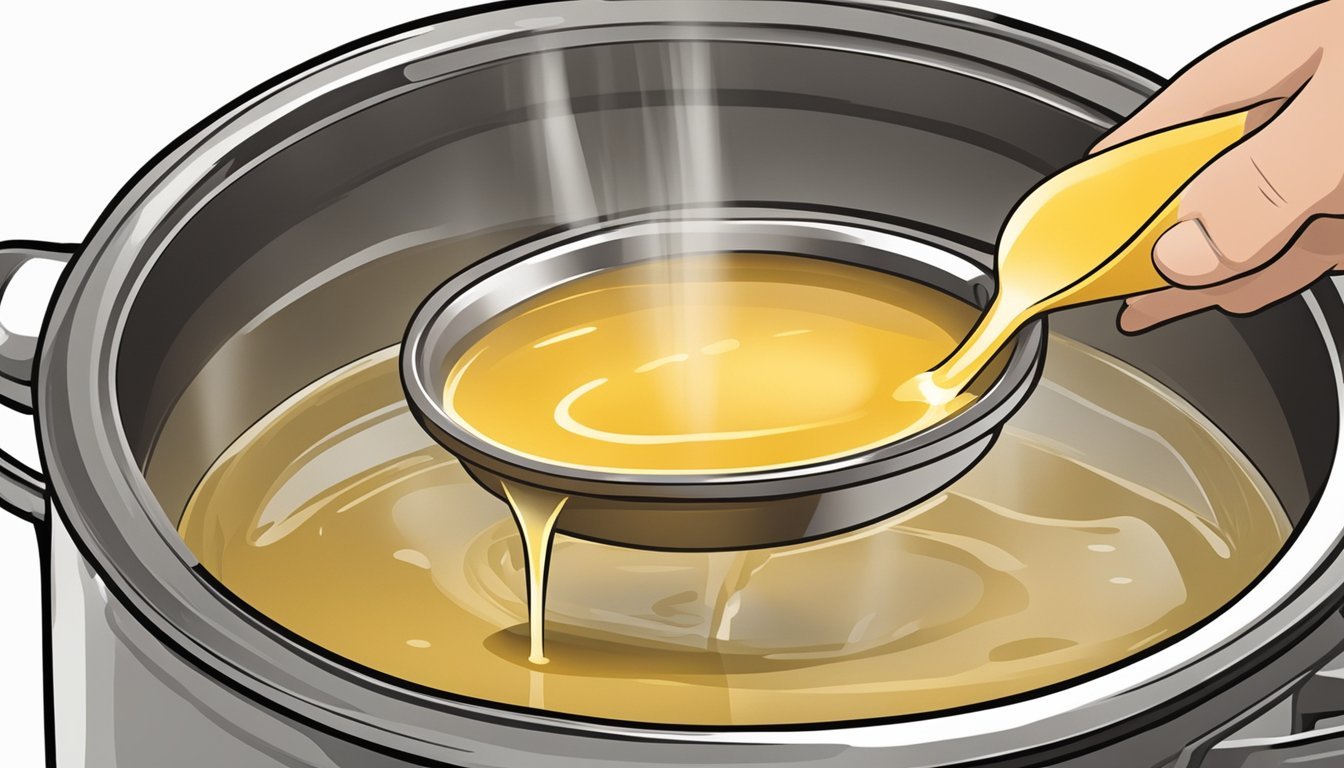How to Substitute Beef Broth for Chicken Broth
Seamless Kitchen Swaps
Substituting beef (What wine goes well with beef?) broth for chicken broth is a straightforward process that can enrich the flavor profile of various dishes. The robust and hearty taste of beef broth provides a deeper flavor compared to the lighter, more subtle taste of chicken broth. When a recipe calls for chicken broth, using beef broth instead is an acceptable practice, especially in recipes where the meaty depth of flavor is desirable. The key to a successful substitution lies in understanding the taste dynamics of each broth and how they contribute to the overall dish.
In making the switch from chicken to beef broth, it is essential to consider the intensity of flavors. Beef broth generally yields a more pronounced savory note due to the gelatin and richer flavors extracted from beef bones and connective tissues during the cooking process. This characteristic makes it a suitable substitute in stews, gravies, and soups that can benefit from a stronger foundation. To replace chicken broth with beef broth, it is recommended to use a one-to-one ratio, though adjustments can be made according to personal taste and the specific requirements of the dish.
While beef broth can act as a perfect stand-in for chicken broth, it is important to note the potential changes in the dish's final color and taste. For those seeking a lighter profile, dilution with water can temper the intensity of the beef broth. This alternative caters to those who prefer a closer match to chicken broth's milder flavor but still wish to incorporate the richness of beef.
Understanding Broth Basics
In exploring the potential of broth substitutions, it's essential to grasp the foundational qualities of broths, their types, differences from stocks, and inherent health benefits. Key elements such as protein content and vitamin levels play a role in their nutritional value and cooking applications.
Types of Broth
Broths are flavorful liquids obtained by simmering meats, vegetables, and herbs. They include:
Beef Broth: Made by simmering beef parts, containing protein and minerals.
Chicken Broth: Made from chicken parts, usually lighter in flavor, enriched with collagen.
Vegetable Broth: A blend of various vegetables, often used as a base for vegetarian dishes (What wine goes well with vegetarian dishes?) and a good source of vitamins and fiber.
Types can vary depending on the primary ingredient used and the simmering time, which affects the intensity of the flavor.
Broth vs. Stock
While often used interchangeably in cooking, broth and stock have distinct characteristics:
Broth:
Typically seasoned with salt and other spices.
Made with meat and may include bones.
Cooked for a shorter period.
Lighter in flavor and texture.
Stock:
Not seasoned to remain versatile for different recipes.
Primarily made with bones, often roasted to enhance flavor.
Cooked longer to extract collagen, leading to a richer texture.
Health Benefits of Broth
Broths are not just culinary essentials; they possess various health benefits:
High in protein, aiding muscle repair and growth.
Enriched with collagen from simmered bones, which supports skin and joint health.
Can be a source of vitamins and minerals, depending on the vegetables and meats used.
Often lower in calories, making them a supportive component in balanced diets.
Homemade broths can be lower in salt compared to store-bought varieties, offering better control over sodium intake.
The Principles of Substitution
When substituting chicken broth for beef broth, it is vital to match the flavor profiles closely, measure salt content and seasonings appropriately, and understand how different broth substitutes can be used.
Flavor Profiles
Beef broth and chicken broth have distinctive flavors that can impact the overall taste of a dish. Beef broth typically has a deeper, richer flavor compared to the lighter taste of chicken broth. When substituting, one should consider the intensity of the flavor that the recipe intends to deliver. For a closer match, using beef bouillon or granules dissolved in water can replicate the concentration of flavors found in beef broth.
Salt Content and Seasonings
The salt content in beef and chicken broths can vary. Many substitutes, especially bouillon cubes or granules, can have higher sodium levels. It is essential to taste and adjust to prevent the dish from becoming too salty.
Seasonings in broth contribute significantly to its flavor. When substituting chicken broth for beef broth, one can add herbs and spices typically associated with beef dishes to achieve a similar taste. A blend of these additional seasonings may include:
Thyme
Rosemary
Garlic powder
Onion powder
Incorporate these with care, starting with small amounts and adjusting to taste.
Using Broth Substitutes
There are several options for those looking for vegetarian or vegan substitutes for beef broth while maintaining similar flavors. Liquid aminos, which are a less salty alternative to soy sauce, can offer a umami depth that mirrors certain aspects of beef's flavor.
For those who do not require a vegetarian substitute, using bouillon can provide a similar savoriness to that of traditional broths. One can dissolve bouillon cubes or granules in hot water as per the instructions, generally one cube or one teaspoon per cup of hot water.
In all cases, the key is to evaluate the final flavor and ensure it complements the other ingredients within the recipe.
Preparing to Substitute
When a recipe calls for chicken broth and only beef broth is available, it's essential to understand how to modify the recipe and consider dietary needs and proper quantity adjustments.
Adjusting Recipes
Recipes are designed with specific ingredients in mind, but they can be adapted when substitutions are necessary. Replacing chicken broth with beef broth might alter the final dish's flavor profile, given that beef broth has a deeper, more robust taste. To maintain the intended taste when using beef broth, one might consider adding water to dilute the stronger flavor or incorporating wine or beer for a different, yet complementary taste. Soy sauce added in small quantities can enhance umami without overpowering the dish.
Considering Dietary Restrictions
Substituting beef broth should take into account any dietary restrictions of those who will consume the meal. For instance, beef broth is not suitable for a vegetarian or vegan diet, while chicken broth would not be acceptable for someone adhering to a pescatarian diet. Alternatives like vegetable broth or coconut milk could be employed instead, always checking the labels for any hidden animal-derived ingredients if catering to dietary restrictions.
Calculating Quantities
When substituting beef broth for chicken broth, it's crucial to use the correct quantities to ensure the dish retains its intended flavor and consistency. As a general rule, beef broth can be substituted in a 1:1 ratio with chicken broth. However, minor adjustments might be necessary based on the dish. Here's a simple reference for substitution quantities:
Substitute Quantity Note Beef Broth 1 cup beef broth per 1 cup chicken broth Adjust with water if needed Water + Salted/Melted Butter 1 cup water + 1 tbsp butter per 1 cup chicken broth Only use if richness is desired Milk 1 cup milk per 1 cup chicken broth Use in creamy dishes Wine, Beer, or Soy Sauce Add to taste, start with small amounts For enhanced flavor complexities
Bear in mind that using substitutes like milk can also change the texture, making the dish creamier, which may not always be desired.
Substitute Options and Alternatives
When substituting beef broth for chicken broth, it is essential to consider the flavor profiles of your dish. The objective is to maintain a rich and savory quality that complements the other ingredients. Here are some alternatives to beef broth that can be used effectively in soups, sauces, and other dishes where chicken broth is traditionally utilized.
Vegetable Broth
Vegetable broth is a suitable alternative for those seeking a vegetarian option or simply a different flavor profile. It's typically made by simmering vegetables such as carrots, onions, and celery (how long does celery last?) along with herbs like thyme or bay leaves. This creates a light yet flavorful liquid that can replace beef broth cup for cup.
Ingredients:
Carrots
Onions
Celery
Herbs (e.g., thyme, bay leaves)
Preparation: Simmer vegetables and herbs in water.
Use: Substitute equal amounts for beef broth.
Water and Seasonings
In the absence of broth, water can be fortified with various seasonings to mimic the depth of flavor found in beef broth. Adding a combination of salted butter, olive oil, or a touch of vinegar can enhance the resulting mixture. The addition of these ingredients should be adjusted according to taste.
Ingredients:
Water
Salted butter or olive oil
Vinegar or lemon juice (for acidity)
Preparation: Combine chosen seasonings with water and adjust to taste.
Use: Substitute the seasoned water for beef broth in the same quantity.
Non-Broth Liquids
Non-broth liquids like wine or dashi can serve as excellent substitutes for beef broth, particularly in dishes where their distinct flavors are desired. A dry red or white wine can add acidity and richness to sauces, while dashi, a Japanese broth made from fish and kelp, imparts a unique umami flavor.
Ingredients:
Wine (red or white)
Dashi
Preparation: Use directly or dilute with water if necessary.
Use: Replace beef broth with wine or dashi, maintaining the quantity required by the recipe.
Advanced Substitution Techniques
In substituting beef broth for chicken broth, one can employ methods that maintain or even enhance the flavors of the original recipe. Techniques such as deglazing with appropriate substitutes, adding depth to the flavor profile, and creating homemade broths are instrumental for a seamless transition in recipes.
Deglazing with Substitutes
When a recipe calls for deglazing with chicken broth, one could instead use beef broth or an alternative like wine that complements the beef's richness. Red wine works well for red meats (What wine goes well with red meat?), while white wine can be ideal for lighter dishes. The key is to use substitutes that balance the dish's flavor profile without overwhelming it.
Creating Depth of Flavor
Enhancing the flavor of beef broth can be achieved by incorporating herbs, aromatics, and spices. These could include rosemary, thyme, or bay leaves. To mimic the complexity of chicken broth, one might experiment by adding ingredients traditionally found in chicken broth such as garlic or celery.
Aromatic Combinations to Add:
Garlic, onion, bay leaves
Celery, carrots, parsley
Leek, peppercorns, cloves
Homemade Substitutes
Preparing homemade beef broth can be more flavorful than store-bought versions, allowing precise control over the flavor profile. Simmer beef bones with aromatic vegetables and a splash of vinegar to extract all the nutrients and flavors. This bone broth can then be used in place of chicken broth in any recipe, offering a robust and personalized flavor foundation.
Specific Dish Adjustments
When substituting beef broth for chicken broth, one must consider how the deeper, richer flavor of beef broth will impact the dish, particularly in terms of its compatibility with other ingredients and the final taste profile.
Soups and Stews
For soups and stews where the liquid plays a central role, the substitution of beef broth requires a mindful adjustment to seasoning, as its robust flavor can dominate other ingredients. For instance:
In a vegetable stew, one might reduce the quantity of beef broth and supplement with water to avoid overpowering the flavors of the vegetables.
Beef broth in a chicken noodle soup can work if herbs are adjusted accordingly, potentially increasing bay leaves and thyme to complement the beefy undertones.
Sauces and Gravies
Sauces and gravies can benefit from the body and depth beef broth provides, but they may call for a reduction in salt elsewhere in the recipe due to the broth's inherent seasoning.
A bechamel might usually call for chicken broth, but using beef broth can turn it into a more umami-rich and deeply flavored Mornay sauce, suitable for dishes like lasagna.
For gravies, beef broth imparts a meatier note, making it excellent for red meats but potentially too heavy for poultry or fish.
Rice and Grain Dishes
In dishes featuring rice, quinoa, or other grains, beef broth introduces a heartier flavor profile.
When cooking rice, especially for a side dish, replacing the chicken broth with an equal amount of beef broth infuses a more pronounced flavor, pairing well with red meat entrees.
For grains like quinoa, which typically have a subtle taste, the beef broth can overwhelm, so using a half-and-half mix with water can balance the intensity while still enriching the dish.
Enhancing Umami and Richness
When substituting beef broth with chicken broth, it's essential to replicate the depth of flavor. Umami, a savory taste, is key in achieving a richness akin to beef. Ingredients focused on umami can greatly enhance the chicken broth, while richness without meat can be achieved through creative methods.
Umami-Rich Ingredients
To boost the umami in chicken broth, one can incorporate certain ingredients that are naturally high in glutamates, compounds responsible for the umami flavor. These include:
Mushroom broth: A vegetarian-friendly option that brings a depth similar to beef broth.
Tomato paste: Its concentrated flavors can intensify the umami.
Parmesan rind: Adding a piece of Parmesan rind to the simmering broth imparts a nutty, savory umami.
Miso paste: Miso, particularly the red or dark variety, adds a powerful umami punch.
Nutritional yeast: Sprinkling in nutritional yeast brings out a cheese-like umami flavor.
Richness without Meat
Cultivating richness in a broth without relying on meat can require creative techniques. Some strategies include:
Vegetarian and vegan approaches: Utilizing plant-based ingredients that have a naturally robust flavor profile.
Slow simmering: Prolonging the cooking time of the broth helps in extracting maximum flavor from ingredients.
Layering flavors: Intentional sequencing of adding ingredients increases the complexity of the broth.
Incorporating these elements enhances the chicken broth, adequately compensating for the absence of beef, and creating a richness and complexity in flavor.
Practical Kitchen Tips
In substituting beef broth for chicken broth, managing pantry staples, cooking equipment, and reducing waste are crucial. The key is to use ingredients that mimic the rich flavors of beef broth and apply cooking techniques that enhance these flavors.
Pantry Management
Maintaining a well-stocked pantry allows one to create a beef-like broth using chicken broth and pantry staples. Having seasonings and basic vegetables on hand is essential. A table of suggested substitutions:
Pantry Item Purpose Salt Enhances flavor profiles. Garlic Adds depth and richness. Onions Contributes a base savoriness. Celery and Carrots Offer subtle sweetness and aromatics. Wine or Vinegar Provides acidity and complexity. Bay leaves and Parsley Bring herbal notes to the forefront.
Cooking Equipment
The right pan can make a significant difference in the quality of the broth. Utilizing a heavy-duty pan ensures even heat distribution, allowing the seasonings and vegetables, such as garlic, onions, celery, and carrots, to brown and develop complex flavors, known as the Maillard reaction. Here, the addition of herbs like bay leaves and parsley in a simmering process helps enrich the broth.
Leftover and Waste Reduction
One should aim to minimize waste by using leftovers to enhance the chicken broth. Leftover potatoes can add body to the broth, while the remnants of a roast, including bones and pan drippings, can contribute to a more robust flavor profile, getting one closer to the richness typically found in beef broth. Here’s how to repurpose common leftovers into a richer broth:
Vegetable Scraps: Save peels and ends of onions, garlic, celery, and carrots.
Meat Bones: Roasted beef or chicken bones deepen umami flavors.
Herb Stems: Don't discard parsley or celery leaves; they can be simmered for aroma.
Maintaining a disciplined approach to pantry management, utilizing proper cooking equipment, and being resourceful with leftovers can effectively replicate the taste and quality of beef broth using chicken broth.
Conclusion
When substituting beef broth for chicken broth, one can proceed with confidence knowing that various options are available to achieve a desirable outcome. The key to a seamless substitution lies in understanding the unique flavor profiles of each broth and how they complement different dishes.
Substitute Ratios:
1:1 ratio: The simplest method is to use beef broth in the same quantity as chicken broth to maintain the intended liquid balance of recipes.
Flavor Considerations:
Enhanced richness: Beef broth generally has a deeper, more robust flavor than chicken broth, which can enrich the final dish.
Herbs and Seasonings: Adjusting spices can help bridge any flavor differences. Incorporating herbs like thyme or oregano may bring the dish closer to the intended chicken broth profile.
To achieve the best culinary results, individuals can utilize their culinary expertise to tailor the beef broth substitution to their specific recipe. With these guidelines, anyone can adapt their cooking to accommodate the available ingredients without sacrificing quality or flavor.
By embracing the flexibility of beef broth as a substitute, cooks expand their repertoire and ensure a prepared kitchen ready to tackle any culinary challenge.








